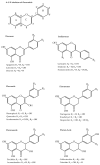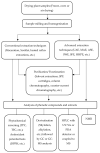Phenolics from Medicinal and Aromatic Plants: Characterisation and Potential as Biostimulants and Bioprotectants
- PMID: 34770752
- PMCID: PMC8588183
- DOI: 10.3390/molecules26216343
Phenolics from Medicinal and Aromatic Plants: Characterisation and Potential as Biostimulants and Bioprotectants
Abstract
Biostimulants and bioprotectants are derived from natural sources and can enhance crop growth and protect crops from pests and pathogens, respectively. They have attracted much attention in the past few decades and contribute to a more sustainable and eco-friendly agricultural system. Despite not having been explored extensively, plant extracts and their component secondary metabolites, including phenolic compounds have been shown to have biostimulant effects on plants, including enhancement of growth attributes and yield, as well as bioprotectant effects, including antimicrobial, insecticidal, herbicidal and nematicidal effects. Medicinal and aromatic plants are widely distributed all over the world and are abundant sources of phenolic compounds. This paper reviews the characterisation of phenolic compounds and extracts from medicinal and aromatic plants, including a brief overview of their extraction, phytochemical screening and methods of analysis. The second part of the review highlights the potential for use of phenolic compounds and extracts as biostimulants and bioprotectants in agriculture as well as some of the challenges related to their use.
Keywords: aromatic; bioprotectant; biostimulant; medicinal; phenolic.
Conflict of interest statement
The authors declare no conflict of interest.
Figures



References
-
- Carvalho F.P. Pesticides, environment, and food safety. Food Energy Secur. 2017;6:48–60. doi: 10.1002/fes3.108. - DOI
-
- Bulgari R., Cocetta G., Trivellini A., Vernieri P., Ferrante A. Biostimulants and crop responses: A review. Biol. Agric. Hortic. 2015;31:1–17. doi: 10.1080/01448765.2014.964649. - DOI
-
- Rafiee H., Naghdi Badi H., Mehrafarin A., Qaderi A., Zarinpanjeh N., Sekara A., Zand E. Application of plant biostimulants as new approach to improve the biological responses of medicinal plants—A critical review. J. Med. Plants. 2016;15:6–39.
Publication types
MeSH terms
Substances
Grants and funding
LinkOut - more resources
Full Text Sources
Miscellaneous

